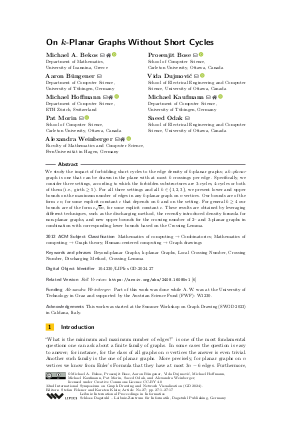@InProceedings{bekos_et_al:LIPIcs.GD.2024.27,
author = {Bekos, Michael A. and Bose, Prosenjit and B\"{u}ngener, Aaron and Dujmovi\'{c}, Vida and Hoffmann, Michael and Kaufmann, Michael and Morin, Pat and Odak, Saeed and Weinberger, Alexandra},
title = {{On k-Planar Graphs Without Short Cycles}},
booktitle = {32nd International Symposium on Graph Drawing and Network Visualization (GD 2024)},
pages = {27:1--27:17},
series = {Leibniz International Proceedings in Informatics (LIPIcs)},
ISBN = {978-3-95977-343-0},
ISSN = {1868-8969},
year = {2024},
volume = {320},
editor = {Felsner, Stefan and Klein, Karsten},
publisher = {Schloss Dagstuhl -- Leibniz-Zentrum f{\"u}r Informatik},
address = {Dagstuhl, Germany},
URL = {https://drops.dagstuhl.de/entities/document/10.4230/LIPIcs.GD.2024.27},
URN = {urn:nbn:de:0030-drops-213117},
doi = {10.4230/LIPIcs.GD.2024.27},
annote = {Keywords: Beyond-planar Graphs, k-planar Graphs, Local Crossing Number, Crossing Number, Discharging Method, Crossing Lemma}
}

 Creative Commons Attribution 4.0 International license
Creative Commons Attribution 4.0 International license
